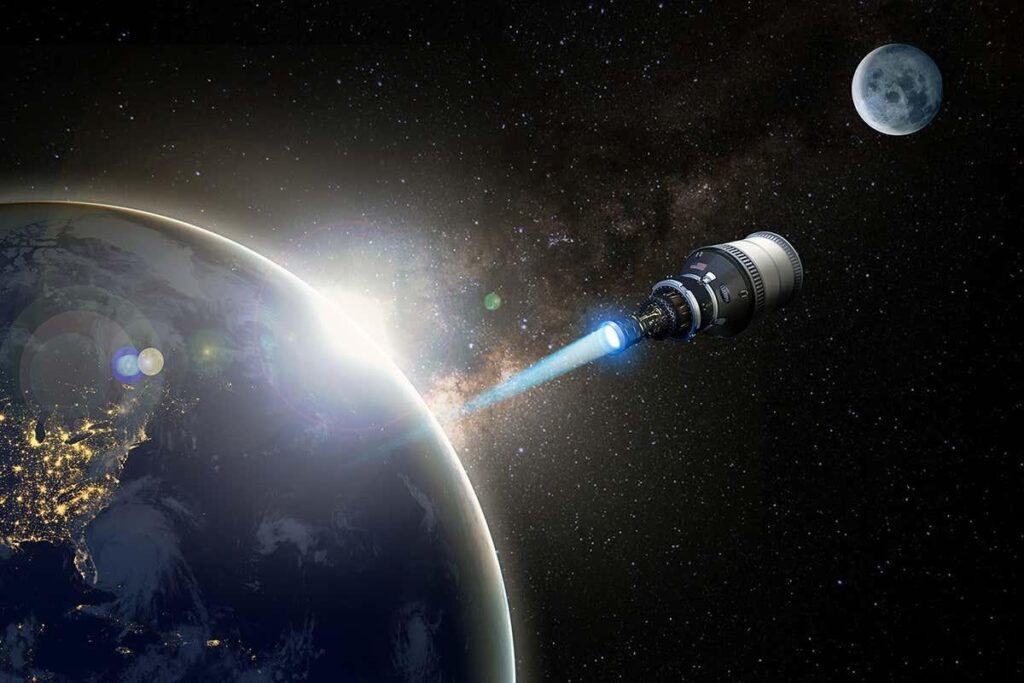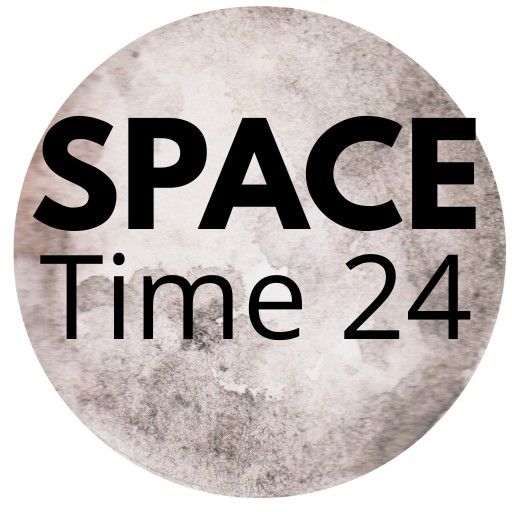Nuclear-Powered Reusable Rocket is one of the most ambitious and transformative goals in modern space exploration. As space agencies and private companies look beyond Earth orbit to Mars and deep space, the limitations of traditional chemical propulsion are becoming more apparent. This has led to a renewed focus on nuclear thermal propulsion (NTP) and the potential for reusable nuclear-powered spacecraft.
In this article, we explore how near we are to developing and launching nuclear-powered reusable rockets, what progress has been made, and what challenges remain.

Understanding Nuclear-Powered Reusable Rocket Technology
A nuclear-powered rocket differs from traditional chemical rockets by using a nuclear reactor to generate the energy needed to propel the spacecraft. The most promising type is the nuclear thermal propulsion (NTP) system. In NTP, a reactor heats a propellant—typically liquid hydrogen—which is then expelled through a nozzle to produce thrust.
Advantages of Nuclear Thermal Propulsion:
- Higher Efficiency: NTP engines offer 2 to 5 times higher specific impulse than chemical rockets.
- Faster Travel: They significantly reduce travel time to destinations like Mars.
- Reduced Fuel Requirements: Less fuel is needed, allowing for more cargo or lighter launch masses.
- Deep-Space Capability: Suitable for missions to the Moon, Mars, and outer planets.
The Goal: Nuclear-Powered Reusable Rocket
Reusability is a key feature in lowering the cost and increasing the sustainability of spaceflight. Companies like SpaceX have demonstrated how reusable chemical rockets can revolutionize space access. Applying the same principle to nuclear-powered rockets could multiply these benefits.
A reusable nuclear rocket would be capable of multiple missions without needing a full rebuild or replacement of its reactor or core systems. This could dramatically reduce mission costs and enable long-term space operations, such as cargo transport, human exploration, and even space mining.
Current Projects and Progress Toward Nuclear Reusability
1. NASA and DARPA’s DRACO Program
The most active and promising project related to nuclear rocket development is DRACO (Demonstration Rocket for Agile Cislunar Operations). This is a joint effort by NASA and the U.S. Defense Advanced Research Projects Agency (DARPA).
- Objective: Demonstrate a working nuclear thermal propulsion system in space by 2027.
- Partners: Lockheed Martin (prime contractor), BWX Technologies (reactor development).
- Fuel Type: HALEU (High-Assay Low-Enriched Uranium), which is safer and more manageable than weapons-grade fuel.
- Status: Reactor and propulsion system design is in progress. Ground testing is expected before the first flight demonstration.
Although DRACO’s first mission is not designed to be reusable, it will provide essential data to inform future reusable nuclear propulsion systems.
2. Advanced Fuel and Materials Research
Key to reusability is the ability of reactor components to withstand repeated thermal and radiation stress. U.S. research labs such as Oak Ridge National Laboratory are developing new fuel coatings and structural materials capable of surviving multiple flights. This includes testing fuel behavior in simulated space environments and ensuring structural integrity over time.
3. SpaceX and the Vision for Deep Space Travel
While SpaceX is not currently developing nuclear propulsion systems, its fully reusable Starship could one day integrate with a nuclear-powered upper stage or interplanetary transport system. Elon Musk has expressed interest in faster Mars travel, which may eventually require non-chemical propulsion. Future upgrades to Starship or other platforms could include nuclear modules once the technology matures and regulatory approval is obtained.
Technical and Regulatory Challenges
Despite the progress, significant challenges must be overcome before reusable nuclear-powered rockets become reality.
1. Safety and Public Concerns
Launching a rocket with a nuclear reactor on board poses serious safety concerns. Even though the reactor is not activated until it reaches space, public perception and regulatory scrutiny are major hurdles.
2. Reactor Durability
To be reusable, a nuclear propulsion system must endure multiple launches, operations in space, and reentries without requiring full replacement. This demands innovations in thermal protection, fuel containment, and mechanical resilience.
3. Heat Management
Reusability requires safe and efficient cooling systems, especially for nuclear reactors that operate at extremely high temperatures. Systems must be able to manage this heat without degrading over time.
4. Policy and International Law
Space nuclear launches are governed by strict U.S. regulations and international treaties. Any move toward reusable nuclear systems will require long-term cooperation between space agencies, defense departments, and environmental oversight bodies.
Timeline: When Could Reusable Nuclear Rockets Become Reality?
- 2027: First in-space demonstration of a nuclear thermal propulsion system via the DRACO mission.
- Late 2020s to 2030s: Based on test results and continued research, reusable nuclear systems could enter development.
- Early to Mid-2030s: Possible launch of a reusable nuclear rocket, depending on regulatory clearance, funding, and technical readiness.
While the exact timeline may shift, the foundations are being laid today. The combination of nuclear propulsion and reusability is seen as a long-term solution for sustainable, large-scale space exploration.
Why This Technology Matters for the Future
nuclear-powered reusable rockets are not just an engineering achievement—they represent a new phase of human space exploration. They can:
- Reduce mission costs dramatically
- Enable permanent lunar bases
- Support human missions to Mars
- Expand deep space exploration to outer planets
- Accelerate space logistics and cargo missions
With the right investments, collaborations, and scientific breakthroughs, nuclear reusable rockets could become a key component of the next space age.
Conclusion
We are not far from seeing the first test flights of nuclear-powered reusable rockets. While full reusability is still a future goal, ongoing programs like NASA and DARPA’s DRACO are laying the groundwork. With advances in materials science, reactor design, and reusable spacecraft technology, a nuclear-powered reusable rocket could become a reality within the next decade.
This progress marks a critical step toward faster, safer, and more affordable space missions—bringing us closer to a future where humans can explore and settle other worlds.
Official News Source:-
https://www.nasa.gov/news-release/nasa-darpa-will-test-nuclear-engine-for-future-mars-missions/
https://x.com/newscientist/status/1381850311573303298?t=7jYOTogjTDZLScmB10RLAw&s=19
About Nuclear-Powered Reusable Rockets: FAQs
1. What is a nuclear-powered rocket?
A nuclear-powered rocket uses a nuclear reactor to heat a propellant, typically liquid hydrogen, which is then expelled through a nozzle to generate thrust. This method, known as nuclear thermal propulsion (NTP), provides significantly higher efficiency than chemical propulsion systems.
2. How is a Nuclear-Powered Reusable Rocket different from current chemical rockets?
Chemical rockets rely on combustion to produce thrust, which limits their efficiency and fuel range. Nuclear-powered rockets use reactor-generated heat, allowing them to achieve much higher specific impulse, faster travel speeds, and reduced fuel mass.
3. Are nuclear-powered rockets reusable?
Not yet. Current nuclear propulsion programs like DRACO are focused on demonstrating the technology in space. Reusability is a future goal, which would require the reactor and engine components to withstand multiple launches and missions without significant degradation.
4. What are the benefits of a Nuclear-Powered Reusable Rocket?
- Lower mission costs over time
- Increased cargo and crew capacity
- Faster travel to Mars and beyond
- Long-duration operations without frequent refueling
- Greater mission flexibility and deep space capability
5. Is NASA working on a Nuclear-Powered Reusable Rocket?
Yes. NASA is partnering with DARPA on the DRACO program, which aims to demonstrate a working nuclear thermal propulsion system in orbit by 2027. The project is led by Lockheed Martin with reactor development by BWX Technologies.
6. When will the first nuclear-powered rocket launch?
The first in-space demonstration of a nuclear-powered rocket is currently scheduled for 2027 under the DRACO program. Reusability features are expected to follow in later projects, possibly in the early 2030s.
7. What type of fuel will nuclear rockets use?
Most designs use High-Assay Low-Enriched Uranium (HALEU), which is safer than weapons-grade uranium and suitable for compact, high-power reactors intended for space missions.
8. What are the risks of launching a nuclear rocket?
The main concerns include radiation safety, reactor containment during launch failures, and environmental impact. To mitigate these risks, the reactor is typically kept inactive during launch and only activated once safely in space.
9. Can SpaceX or other private companies build nuclear-powered rockets?
While SpaceX has not yet announced a nuclear propulsion program, future deep space missions may require non-chemical propulsion. Private companies may become more involved once the technology matures and receives regulatory approval.
10. How does nuclear propulsion help with Mars missions?
Nuclear thermal propulsion can significantly reduce the time needed to reach Mars—from 9 months to approximately 4–5 months. This reduces astronaut exposure to cosmic radiation and increases overall mission safety and efficiency.
